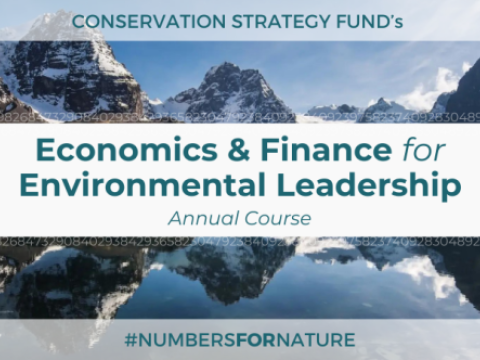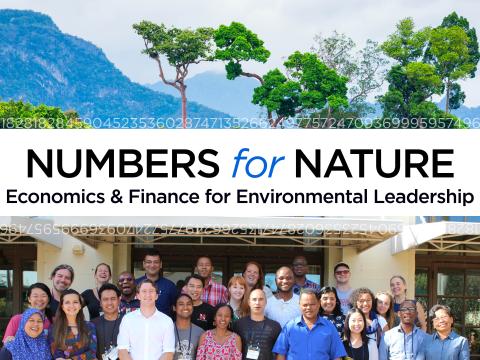A Conversation with Dave Adema, 2025 Course Graduate
“If you can walk away in life having at least forestalled the exploitation of a place, I think you’ve won.”
This August, 28 environmental professionals came together for Conservation Strategy Fund’s flagship course, Economics and Finance for Environmental Leadership, hosted in person at Stanford University. Our 2025 course cohort represented 19 different countries and over 25 different organizations and institutions, ranging from government research to independent consulting and indigenous leadership.
Our Global Communications Manager, Samantha Meyers, sat down with one of our course attendees, Dave Adema, SEEA Ocean Accounts Advisor for the Ministry of Finance in Palau, to reflect on his course experience. The Republic of Palau has been recognized as a global conservation leader as the first and only nation to protect 80% of its waters and require all visitors to sign a “Palau Pledge” to promote environmental stewardship. The nation is also a trailblazer in conservation finance, instituting green fees for tourists, launching a blockchain-based savings bonds system, and drawing significant investment from the Bezos Earth Fund. As a seasoned economist working to build economic arguments that safeguard Palau’s environment, we asked him what brought him to this field of work, why he took this course, and what he’s gained from this experience.
Here’s some of what Dave had to say...
Q: I just want to hear a little bit from you about your experience in the course. So, can we start with who you are, and what you’re working on?
A: So I work for the Ministry of Finance in Palau, setting up a system of environmental and economic accounting. I've been working in Palau for about ten years [and] aware of and visiting the place since…yeah, at least twenty years. [I am] currently working to come up with the natural capital assessment. So extent, condition, and value of mangrove seagrass and coral in Palau, and then the energy and water accounts.
Q: What brought you to this role?
A: I started taking an interest in natural capital after someone gave me the textbook for my birthday back in 2018, and it really aligned with a lot of my theses on where things needed to go because I had been studying sustainability since the late 90’s. And then I went for a degree after my first Peace corps assignment in the Philippines on small business development for displaced fishermen. In 2008, graduated at the bottom of the financial crisis in 2009, so yeah I sorta watched sustainability come and go, and its momentum, and over that time period. I also went to school in Sweden to study sustainability from Dr. Karl-Henrik Robert, who's the guy who started the natural step in the framework for strategic sustainable development. And it was a really noble approach, but it suffered from wonky ivory tower implementation barriers, right? Really sticking to the framework and not being willing to adapt and simplify to developing country contexts. So, over time, I became more and more jaded in terms of sustainability…and when I first read about natural capital, it was a different take on it…I realized that was really the most realistic solution…The more I read into the text, the more difficult I realized it was. And I had an extensive, wide background, but you really need the widest possible background across as many possible disciplines to succeed in this field. So I went back to school in 2021 to refine those skills, to be able to take it to a much higher level and prove the business cases, develop the projects, and understand the core sciences that go into it…[Now,] for me, it's all about finding those more challenging ecosystems and highlighting where those jobs come from and where the economic growth comes from.
Q: So do you find Palau to be one of those sort of challenging ecosystems?
A: What's particularly challenging about Palau is that it's at the place everyone wants to be - where you aspire to be, right? Palau's mangrove system has been expanding for the last hundred years at an overall rate of around 7%. And so the pressure now is to develop. And we get a lot of money thrown at us because we're the first to do everything from shark protections to closing down commercial fishing. And they're all noble causes, but it's really tempting to take that development money. And it's hard to tell people that they can't have a beachfront because most of Palau is a mangrove waterfront. And they're already reaping the benefits of its protection and its provisioning services…so it's difficult to put that money in the hands of people right now where a development project does just that. Counteracting that backward slide is a true challenge…and so aside from a payment from ecosystem services scheme, it's tough to convince people of what they're already receiving - for a healthy ecosystem.
Q: What position do you play in making those arguments for nature?
A: I'm in a position of sharing knowledge. I'm never the public face. And I don't desire to be the public face…It's all about just providing people with data they need...I mean, my goal is to make sure these places continue to exist in the best and most natural form they can. The world likes to call us pristine, but even young Palauans know our environment is not pristine as well. They understand shifting baselines. If you can walk away in life having at least forestalled the exploitation of a place, I think you’ve won.
Q: Well, regardless of the tradeoffs you’re doing really great work. I'm really curious, because you have so much experience in this realm - What drew you to this course?
A: Mostly the opportunity to bring the two young Palauan ladies, [Adeeshia Imade Tellei and Dilibgnal (Dili) Mira], that are with me here for review, [and] some more exposure to the NatCap team. Honestly, I've never heard of CSF. I hear of so many conservation groups and I've done my fair research on conservation groups and did network modeling of conservation groups in my first masters. But the array of groups that show up and do work in Palau, it's just thousands. Unfortunately I hadn't heard of CSF earlier, because I really liked the way the course was designed. It's a strong team. And the partnership with Natural Capital Project is excellent...But [anyway,] Imade has been dying to do an econ[omics] degree and Dili wants to come back and work in our GIS office and it's really rare that you get a young Palauan that wants to come back and work. They see the money here and they don't want to leave and Dili for instance wants to stay and do a masters here…So just having this kind of exposure for her is, she studied in the States at Eastern Oregon University, but not having a chance to talk to other people that already work in the field is a real handicap. And so for her, there's a benefit there. For Imade, it's a better foundation in economics and for both of them a chance to try and find someone that can help them match up with a good econ[omics] program. Imade, in particular, wants to go back for a degree in economics and Dili's hunting around for her next masters. But yeah, as I said, it's really impressive that both want to stay and work in Palau when there's more money outside and less politics outside.
Q: Well, I'm really curious what your take on the course has been.
A: So I think the team organizes really well, is good at whipping the group into shape when they're late and everything, because we all do it…I know it's very difficult being a facilitator…and it takes a special person and the right attitude and being a glass half full person, I think you are all very much glass half full people. Yeah, I appreciate that there's always the elementary level, like even talking to Jemani [Balderamos] from Belize, right? Like he's so put together, he has a quiet mind, really puts a lot of thought and truly understands the science deeply. But even he's like, “I did not have the economic background at all.” And it's something you take for granted when it's a part of standard undergrad[uate] degrees generally. And so I accept that a big part of it was going to be repetition, that cost benefit analysis would never get into like shadow pricing and you know, like the real nitty gritty of the calculus behind it. And that stuff's extremely challenging. But it's always good to review. I've been studying NPV and present value, future value since undergrad and it doesn't matter. It always catches you up, so it's good to review…
Q: Final question. What is something that someone interested in this course should know about it?
A: I think the answer requires a range of contexts, right? I think if you're new to economics, it's a great way to build a, a systems level understanding of it, very quickly. Or at least get a nice wide picture of the system and how it works. And if you're more senior, it's a good chance to work with others…I was really expecting a lot of young people..but I was relieved that there were so many professionals, right? And that's been one of the greatest benefits of the course is to see how it's applied in other places. And not just, like, theoretical, like, tangential nice benefits of green actions, but people that are actually doing hard work. I think it does a good job of meeting both ends of the spectrum.
Dave is only one of many 2025 Economics and Finance for Environmental Leadership course alumni who reflected on this experience. For more information, read our latest blog post and watch our short video to see what other participants had to say about this transformative course.
To learn more about other conservation economics and finance courses offered by CSF’s Numbers for Nature Training Institute, please visit www.numbersfornature.org.
This course was hosted by Conservation Strategy Fund in collaboration with Stanford’s Natural Capital Project and the Conservation Finance Alliance. Special thanks to the Dry Creek Foundation for providing our participants with scholarship support for this course.
- Log in to post comments


